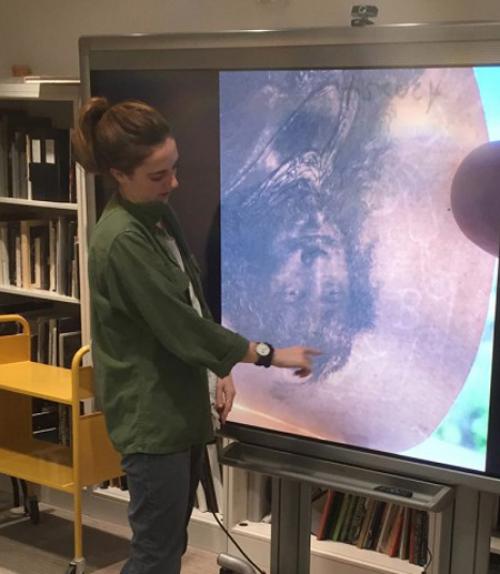Rembrandt van Rijn’s art and artistic practice have fascinated scholars and collectors for centuries. His printmaking methods, and prints from across hiscareer, are revealed as an inspirational resource for research and teaching in a new exhibition of his etchings at the Herbert F. Johnson Museum of Art.
More than 60 impressions by the Dutch artist across a wide variety of subject matter – self-portraits to landscapes – are included in “Lines of Inquiry: Learning From Rembrandt’s Etchings,” through Dec. 17. The exhibition and accompanying catalog highlight learning and teaching using academic collections and explore Rembrandt’s artistic process, such as his practice of reissuing small editions of prints after making subtle changes to the plates.
“It’s an opportunity to learn about Rembrandt as a printmaker in his full breadth, with absolutely gorgeous impressions and a full range of fascinating subjects,” said Stephanie Wiles, the museum’s Richard J. Schwartz Director. “Visitors can deeply understand the artist’s working process through the multiple states on view here.”
Jointly organized with the Allen Memorial Art Museum at Oberlin College (where it goes on display in February), the exhibition draws from collections at Cornell, Harvard, Princeton, Syracuse and Yale universities, Oberlin and Vassar colleges, the University of Kansas, the Morgan Library & Museum and private owners.
Archiving, collecting and scientific study of Rembrandt’s work also are explored, including a cross-disciplinary project at Cornell.
“We started a student research group in 2015 sparked by a Mellon course at the museum, to study Rembrandt’s watermarks,” said “Lines of Inquiry” co-curator Andrew C. Weislogel, the museum’s Seymour R. Askin Jr. ’47 Curator of Earlier European and American Art. “The resulting project has grown to involve a range of fields including art history, engineering, computer science, chemistry, archaeology and history. Its results will be useful for anyone interested in Rembrandt’s prints.”
Watermarks are unique to each batch of paper the artist used, and can often confirm the date or edition of specific impressions. As part of the WIRE (Watermark Identification in Rembrandt’s Etchings) project at Cornell, students have been tasked with creating an online decision tree as a computational tool, which, when completed, will allow users to quickly and confidently identify watermarks from among the 54 main types and more than 500 known subvariants that appear in Rembrandt’s oeuvre, printed from some 300 plates in all.
“This will be an exciting new interface for research. Considering the approximately 250 batches of paper Rembrandt used in his career, many of them with nearly identical watermarks, it’s often hard to make a concrete identification without assistance like this,” Weislogel said.
The project has direct benefits for the students involved, enabling different modes of learning across disciplinary norms – for example, “engineers learning to solve humanities problems,” Weislogel said. “Engineers have the research group, where they work out a problem together, and students in the humanities participate in seminars. WIRE melds those two approaches.”
The WIRE Project received a $75,000 Digital Humanities Advancement Grant from the National Endowment for the Humanities to develop computational methods and tools that will enhance museum and art historical research into Rembrandt and others’ printmaking practices.
“Rembrandt etchings are the most cataloged prints in the world, and it’s been great to see the students, a core group of them, develop a sense of connoisseurship and wonder about his work,” Wiles said.
Weislogel directs the project with professor of electrical and computer engineering C. Richard Johnson Jr., a Jacobs fellow at Cornell Tech this semester. Johnson’s extensive prior computational art history projects have involved research on thread counting in canvases and chain lines and laid lines in pre-1800 papers.
Students in Weislogel and Johnson’s courses at the museum on Rembrandt’s etchings use radiographs of original prints in developing and expanding the computer-assisted decision tree for classifying watermarks, based on the work of Rijksmuseum curator and Rembrandt scholar Erik Hinterding, whose 2006 three-volume series has been the definitive source.
“Nobody has devoted as much energy to this as Hinterding,” Johnson said. “I see him every so often, so I asked him how the expert does this. He wrote me a couple pages about how he would distinguish between two different watermarks.”
Johnson said he realized that “this is 20 Questions. The question you want to ask is, ‘Is it this or that?’ OK, it’s just a decision tree. Once it’s built, anyone can use it, and identify their watermark in two minutes, rather than five hours.”
Students in successive classes have been discovering watermarks Hinterding hadn’t encountered, in American collections such as those participating in “Lines of Inquiry.” Besides the joy of discovery, as a result, they are adding one or two new branches to the decision tree each semester, Johnson said.
The project will boost the museum’s profile (and Cornell’s), he said, as a resource for Rembrandt collectors, aficionados and scholars in dating and authenticating impressions of Rembrandt prints. The information entered in their searches, especially on artworks in private collections, will add to the existing knowledge on Rembrandt via a database of etchings, watermarks and types of paper used.
An academic symposium Oct. 28, “Learning and Teaching With Rembrandt: Cross-Disciplinary Approaches to the Master Etcher,” will examine collaborative research in academic, curatorial and conservation fields and how they extend existing knowledge about Rembrandt’s practice. Weislogel, Johnson and Hinterding are among the presenters, along with Susan Donahue Kuretsky and Elizabeth Nogrady of Vassar College, Nadine Orenstein of the Metropolitan Museum of Art, Margaret Holben Ellis of New York University and Stephanie Dickey of Queen’s University.
This story also appeared in the Cornell Chronicle.




